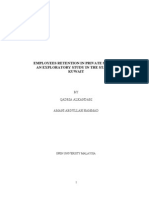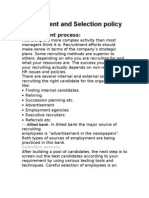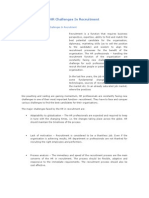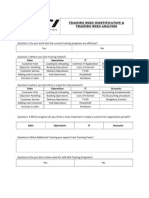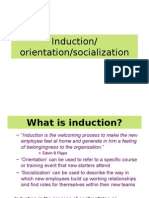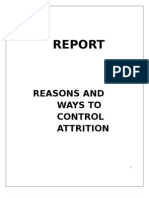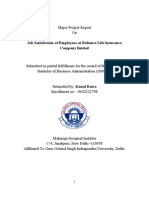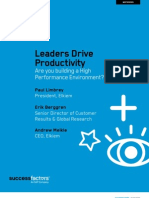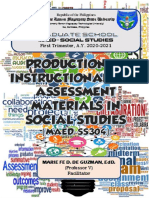Training and Development of HSBC
Training and Development of HSBC
Uploaded by
Ashiqur RahmanCopyright:
Available Formats
Training and Development of HSBC
Training and Development of HSBC
Uploaded by
Ashiqur RahmanCopyright
Available Formats
Share this document
Did you find this document useful?
Is this content inappropriate?
Copyright:
Available Formats
Training and Development of HSBC
Training and Development of HSBC
Uploaded by
Ashiqur RahmanCopyright:
Available Formats
Training And development of HSBC
At HSBC, we believe our primary competitive advantage comes from our employees. It is their ability to provide a superior customer experience to our customers, that sets us apart from other financial services companies. In the ever changing financial services industry, all of us must continuously upgrade our skills and knowledge in order to maintain this competitive advantage. Our goal is to attract, retain and motivate the very best, and to do that we support training, development, and business education through the following:
Internal Training Programmes Seminars, workshops and locally tailor made training on a variety of topics are offered directly by HSBC Training and Development Department at our training centre located at Motijheel.
External Courses Job related courses, seminars, workshops and conferences developed and presented at HSBC Offices in Asia and also at Group Training and Management Development Centre at Bricketwood, UK.
Distance Learning Web-based and multimedia self-study programmes available through our Intranet and multimedia Learning Centres located in our HSBC offices.
Resident Management Trainee Programme (RMT Programme) The Resident Management Trainee programme (RMT) aims to select a group of high potential executive trainees and provide them training and development opportunities. The RMT programme gives potential executives effective and systematic training to acquire an excellent understanding of the commercial operations and business functions. The RMT programme ensures that successful applicants, with the right training, will have the ability and potential to reach the highest level of management within HSBC Bangladesh, and possibly beyond.
Application process stage 4: Assessment centre
We are now accepting applications for the 2011 graduate programme. There are four stages to the graduate recruitment process:
Stage 4: Assessment centre
This is the final stage of the HSBC Private Bank graduate programme selection process.
Our assessment centres are two-way events. Theyre not just designed to help us decide if you're right for us, they help you decide if we're right for you. Youll have plenty of opportunities to find out more about what it's like to work for HSBC, and the kind of roles you could be doing. As always, the best advice is to be yourself and relax as much as possible. The assessment centre revolves around a variety of one-to-one and group-based activities that give you the chance to display the key capabilities we look for in our graduates. We'll give you a clear brief at the beginning of each exercise and there are no tricks or hidden agendas. We won't try to trip you up we genuinely want to give you the best chance to show us what you're capable of. If you havent attended an assessment centre before, these tips may be useful:
Our aim is to find out if you are competent in a range of capabilities so all the exercises are capability-based. We assess every capability at least twice, so dont worry if you think an exercise hasnt gone particularly well for you youll have at least one more opportunity to demonstrate your strength in each capability Be involved during all the exercises. We can only assess your actual contribution during each event we can only consider what you say, not what you may have been thinking Keep an eye on the time during each exercise as it will have a specific time limit You may find the centre tiring. But remember that we look for consistency of performance during the entire event, so try to keep your energy levels and enthusiasm high throughout You'll take part in the assessment centre along with several other candidates. We don't make set numbers of job offers at each centre so you arent in competition with each other We aim to let you know the outcome of the assessment centre within 24 hours
Performance appraisals
Maintaining employees' focus and motivation is essential if they are to make a full contribution to your business. Performance appraisals actively involve employees in understanding what is expected of them. By setting agreed objectives - and later reviewing the results - each employee is responsible for his or her own performance. This briefing outlines: 1. 2. 3. The benefits of using performance appraisals. What to include in the self-assessment form you give to employees. How to prepare for the appraisal meeting.
4.
How to conduct, and follow up, the meeting.
1 Benefits of appraisals
In the rush of everyday work it can be difficult to manage all your employees well. 1.1 By clarifying the employee's key objectives, you make it possible for the employee to achieve or exceed them. You can use a personal development plan approach to increase the desire of the employee to improve.
You use each appraisal to set new objectives with the employee.
1.2 By recognising achievements during the previous period, you create the motivation to achieve even more. Actually saying 'well done' or 'thank you' may seem unimportant to you, but acknowledgements like these are extremely important to the employee. 1.3 By identifying and correcting problems, you improve the employee's productivity. An appraisal provides an insight into the work being done and the employees who are doing it. 1.4 By asking for feedback and ideas, you find out how to improve your business. You can receive useful feedback on your performance as a manager, including your management of other employees. Appraisals show your employees you care about their problems, aspirations and views. Done well, appraisals boost employees' confidence and help them focus on their objectives.
2 Self-assessment questionnaire
Let the employee know well in advance when the performance appraisal will be. Ask the employee to complete a self-assessment questionnaire for you as part of the preparation. 2.1 How well have you performed since your last review? What were your key objectives (see 5) and did you achieve them? What problems did you encounter? What did you do really well? In which areas do you think you could improve your performance? 2.2 How would you rate your own skills? What are your strengths and weaknesses? Are you well organised? Can you work on your own initiative? 2.3 Are you a team worker? How well do you get on with others in your team? How well do you get on with others in the company? 2.4 How is your attitude to work? What do you find most or least interesting in your job? Do you have any interests or abilities which could be better used? How flexible are you? How punctual, reliable and committed are you?
2.5 What do you think your key objectives for the next six months should be? What help and training do you need?
3 Manager's preparation
Prepare a plan for the appraisal meeting. 3.1 Review the employee's completed self-assessment questionnaire. Identify the important issues and focus the appraisal on them. 3.2 Review the performance appraisal report which was written following the previous appraisal (see 6).
Note which objectives have - and have not - been achieved.
3.3 Think about the big picture, as well as operational issues. For example, the career or training opportunities that are open to the employee. 3.4 Work out your objectives for the appraisal. For example, if there is no opportunity for promotion, your goal may be to maintain the employee's commitment and motivation. Deal with any recent one-off problems before the appraisal. 3.5 Have examples (or other evidence) ready to back up the points you wish to make. This shows the employee that your concern is a reasonable one. 3.6 Write down your meeting plan for the appraisal (see 4). The less you have worked directly with the employee, the more effort you need to put into the preparation stage. For example, you may need to seek feedback from other people.
APPRAISING UNDER-PERFORMERS
Carrying out an appraisal of an employee who is under-performing requires particular skill.
Tackle problems as and when they arise, rather than waiting for an appraisal. Confirm what the minimum targets and standards are that the employee should be reaching. These will have been set at the previous appraisal, or earlier. Compare the employee's performance with these targets and standards, which must be measurable. Be supportive, constructive and fair.
4 The appraisal meeting
Appraisals should allow employee and manager to express their views freely and frankly. The eight steps outlined below should help you achieve this. 4.1 Explain the agenda (your plan) for the meeting, and what you hope to achieve. Put the employee at his or her ease. Start on a positive note by praising the employee's work in general. 4.2 Ask the employee to talk you through the self-assessment (see 2), focusing on the areas which you have identified as being the most important - typically the key objectives. Employees can be over-critical of their own performance. They may also identify problems you were not even aware of.
This makes your role much easier. You can focus on helping the employee to find the solutions, rather than having to point out all the weaknesses and problems. 4.3 Add your own views about the employee's performance. Take every opportunity to acknowledge achievements and hard work. Be clear about which areas of performance need improvement. 4.4 Discuss the problem areas and come up with solutions together. Ask the employee to explain why the problem has occurred. Then ask the employee to suggest a solution, which may match your own ideas. Look beyond the symptoms to the root of the problem. For example, a problem might stem from lack of confidence, lack of training, or something unrelated to work. 4.5 Review the employee's long-term career plans, if these have changed. This may unearth new problems or opportunities. For example, you may realise that the employee is looking for another job - in which case you need to either persuade him or her to stay, or make plans for what will happen when the employee goes. 4.6 Consider the employee's training needs. 4.7 Discuss and agree a new set of key objectives for the next period (see 5). Decide when the next appraisal - or interim meeting - will be. 4.8 Discuss any ideas for improving the effectiveness of the performance appraisal process. The employee may feel that the process has been unfair in some way. Aim to spend twice as much time listening to the employee as you do talking. Much of the skill of doing effective appraisals lies in your questioning technique. If you ask 'open' questions (eg 'what do you think about...?'), and show genuine interest, most employees will be happy to talk at length.
5 Setting key objectives
The whole appraisal cycle is built around setting, reviewing and then re-setting key objectives. 5.1 Each objective should be SMART - specific, measurable, agreed, realistic and time-limited. Each objective must be in an area over which the employee has control. Give each objective a deadline. 'To be a good salesman' fails the SMART test in every way. But, 'to add at least five new customers by the end of the year' might be a suitable objective. 5.2 Many elements of the job may already be covered by set standards . For example:
In an office, you may have standards for answering the phone (within four rings) or handling sales queries (within 24 hours).
For many blue collar employees, much of the appraisal will be focused on reviewing the achievement of standards. For example, the driver of a delivery van might be reviewed primarily in terms of reliability, promptness and breakages. All the general points about appraisals still apply. A van driver needs support and motivation - and has potentially valuable feedback and ideas - like every employee.
5.3 Involve the employee in setting objectives. Otherwise there is a danger the objectives will be unattainable, or simply ignored.
6 Following up
6.1 Immediately after the meeting, write up the performance appraisal report. This summarises what has been discussed and agreed, including:
The objectives set for the next period. Any commitments you or the employee may have made.
For example, you might have offered to train the employee in a particular task. The report may include numerical scores for various categories of activity. 6.2 Give the employee his or her own copy. There should be no surprises. Check that the employee agrees that what you have said is true and fair. 6.3 Give a copy to your own line manager or another third party (such as the personnel manager) to review.
If several managers in your business conduct appraisals, this is a vital check for fairness and consistency.
6.4 There should be an appeals procedure in place, for employees who feel that any part of the appraisal process has been unfair. 6.5 Performance management of the employee is an ongoing process for you. Monitor the employee's progress towards the objectives that have been set. Keep using the supportive, collaborative approach that you used for the appraisal.
Who appraises who, when?
7.1 It is common practice for employees to be reviewed by their line managers. If your appraisal system is ineffective, it is probably due to the poor skills of the managers conducting the appraisals. Train your managers in appraisal skills. Train your employees in appraisee skills,so that they can contribute effectively. 7.2 Bottom-up appraisal is a more comprehensive approach. Each employee is appraised by subordinates, as well as a line manager. 7.3 A 360-degree appraisal is more thorough still, taking in feedback from subordinates, colleagues, superiors, and customers. One advantage of this approach is that the appraisal is less vulnerable to bias. A disadvantage is the sheer amount of time the process consumes. 7.4 The optimum frequency of appraisals depends entirely on the circumstances. At the very least, they should be once a year.
If you are trying to motivate a team and drive the business forward, quarterly appraisals may be more appropriate. An employee who is new, or has moved into a new role, may initially need more frequent appraisals.
Another employee, who has done a routine job for several years, may only need one appraisal a year.
Terms of reference: This report is being produced to fulfil the criteria required for Unit four of the Advance Vocational Certificate of Education (AVCE) course in Business Studies. It will give a comprehensive overview of the way's in which the human resources function(s)', within businesses are organised and managed and how they operate, and an analytical insight into the human resource management team, of the business that I' am focusing on, which is HSBC Group Plc. The report will specifically focus on the possible conflicts of interest between employees or individuals, the way's which human resources planning procedures take place, the recruitment and selection process, training and development programmes and performance management at HSBC Group Plc, in view of the current economic climate for retailing/banking. An Introduction to the Report: In this assignment, I have been asked to structure an analytical approach, about human resources and its effects, on one business, and to file all of my information in one simple, but sophisticatedly structured report. The report will therefore contain the following topics, as of mentioned in the first paragraph (terms of reference), and are as follows: Human Resources Planning: This section involves information regarding human resources planning that would include information creating a strategic plan, in having the right number of employees for a businesses specific needs, which will also include information on the labour market and how they operate, within HSBC, and the effects that the following factors will have on the labour market: * Employment trends; * Any sort of skill shortages; * If there is any forms of competition between employees; * And the availability of labour (both internally and externally which the business (HSBC) can use, as an additional resource. In relation to this section of human resources planning, It would also involve me gathering information on how HSBC organises its labour duties, and several other factors of a wide range of information regarding the process of decision making - in relation to internal staffing, such as information on:
* Labour turnover (stability index, wastage rate, etc.); * Sickness and accidents; * Age, skills and training needs; * And succession. As well to interpreting statistical information, relating to human resources planning (as this will also have a great significance and will contribute a lot, in analysing how the human resource department plans some of their basic activities). Recruitment and Selection: This section will make me cover and gain a sound understanding, of how recruitment and selection is carried out and maintained, throughout one business, and it will involve me in finding out information, on how and why the decision to recruit staff are made, such factors would include: The growth of the business; * Changing job roles within the business; * Filling vacancies created by resignation, retirement, dismissal, etc; * And internal promotion. This section will also help me gain a good coherent understanding, of just how costly recruiting and the selection of employees can be, in terms of resources devoted to the recruitment process and any other costs that are associated with recruiting poor performing staff, and the reasons for it being important to HSBC to accurately select the appropriate individuals for an interview, which is carried out, in order of searching and selecting the right person, and or in other terms of information and the following examples on: * The preparation of personal specifications and job descriptions; * The careful planning of how, where and when to advertise these document or vacancies; * The identifications of the strengths and weaknesses of job applications, is obliged too - and the key implications for recruitment on the following legislations: - Race Relations Act 1976, Equal Pay Act 1970, Sex Discrimination Act 1975 and the Disability Discrimination Act 1995; * The identification of the appropriate use of different methods of
assessment such as psychometric and aptitude testing are carried out; * The identification of good interview skills; * And identifying the criteria for evaluating the recruitment process. I will also have to discuss information on how important it is to HSBC to recruit and maintain a flexible workforce, if they are to remain competitive, and information on the different bases for recruiting people for a flexible workforce, which should include information on such factors, such as: * The different modes of employment used; * Different terms and conditions; * Core employees; * And part-time, temporary and contract labour. And finally relating to this section, I would have to understand, how contracts of employment help HSBC achieve a flexible workforce and how they are put together, and the key implications that seek to protect the rights of employees relating to contracts of employment. Training and Development: I would also need to find the differences and to distinguish between on- the- job training and off- the- job training and transferable and non-transferable skills, which arise from training programmes. And the need for me to understand how nationally recognised qualifications/-training structures, such as Investors in People and Individual Learning Accounts, contribute to how HSBC trains and develops it employees. Performance management: In this section, it would involve me to put information regarding 'performance management', and some examples of the following methods that HSBC uses to manage the performance of its employees: * Performance reviews including appraisals; * Self evaluation; * Peer evaluation; * Target setting for individuals and groups; * Measuring individual and group output/production.
And to find information on just how important training and development is to HSBC, in terms of enhancing the performance of individuals and groups of employees, and the need of being aware for competitive businesses to link performance reviews and evaluations to appropriate training and development needs of individuals. The information of understanding the environment which HSBC attempts to manage the performance of their employees, in particular therefore, I would need to understand the key aspects of legislations affecting factors, such as the maximum number of hours employees can work in a week, etc, the regulations governing leave arrangements (including maternity and paternity leave) and minimum wage rates. And finally within this section I would need to acquire the knowledge of just how employee motivation and the significance of both financial and non-financial factors in terms of motivation, and the identification of the influence that the following motivation theories/ideas have had, on the way's in which HSBC manages its employees: * Frederick Taylor's principles of scientific management; * Abraham Maslow's hierarchy of needs; * Douglas McGregor's Theory X and Y; * Frederick Herzberg's two-factor theory. I would also have to cover the responsibilities that are covered by the human resources function at HSBC, and the importance of these resources to HSBC. I would also need to understand how internal staffing information and external labour market information can help plan human resources at HSBC and how they will use this information. I would also need to understand how any possible conflicts of interest between the human resource functions that would take place, and how they will affect the business. And finally I would need to acquire information based on, the purpose of performance management and HSBC's approach to motivational theory, and information on one human resources job role, with examples of how the work is carried out and how it is evaluated in terms of its contribution to the business. Introduction to Human Resources (Personnel Department). Introduction to & the Definition of Human Resources: The human resource department (personnel department), or as it is formerly known as 'human resources management (HRM)', and what this department is mainly concerned with and significantly contributes to the human side of managing enterprises and employees' relations within
the business itself. However the main purpose of human resources, is quite simply to ensure that the employees of the business, or company, for example the human resources, are adequately and appropriately used in such a way that their employer would obtain the greatest possible benefit from the employees full ability and the employees would therefore obtain both material (financial pay, fringe benefits, bonuses, etc) and psychological rewards from the work that they carry out. Therefore human resources management is mostly situated on the findings of work psychology and it will then use these techniques and procedures that is collectively known as 'personnel management', and such an example is where the human resource department is involved with staffing the enterprise/or business, which would determine and satisfy the needs of people at work that would include obliging practically to rules, regulations and procedures, which govern the relationships between employees, employers and the organisation. In relation to the definition of human resources and the affects that it can have upon one business, is quite dramatic, regarding to being responsible in looking after employees, for example lets say that everyone within a business - working in the same department has control over others, then they would also share in human resources management; however that does not necessarily mean that this is a function which that individual manager/person can avoid and leave to people who are more specialised within that particular field. But this does not exactly mean that human resources are easy to manage, no! In fact these resources are much more difficult to keep under control and manage at the same time, partly due to there being conflicts of interest between both the employers and employees' wishes, or other specific needs and partly due, to an increase to the extent, which employees try to share in making decisions about the environment in which they work in. As Ihave mention in the above paragraphs, human resources in theoretical terms is not necessarily part of the personnel management system; this is partly due to, although this part of management is concerned with people at work and with the relationships that they have within an enterprise. It aims to bring together and develop into an effective organisation, and that it can with ease overcome its competitors, the men and women who are employed make up the organisation as a whole and, having regard for the well-being of individuals, to dramatically play a vital role and to make their best contribution to the organisations success. Reflecting the point(s) that I have just made, the personnel department mainly focuses among the development and application of the policies that govern: * Human resources planning, recruitment & selection, and so on; * The preparation of both accurate and precise job
descriptions/personal specifications and any other recruitment aids; * Education and training; career development; * The maintenance of management training, development and succession planning among the workforce; * The terms of employment, the methods and standards of remuneration; * 'Incentivating', e.g. a method of compiling together a system, to try and simulate workers into work at an enhanced effort/level and to be efficient; * Working conditions and employee services; * Formal and informal communication methods and consultation both through the representatives of both employers and employees throughout all the levels of the enterprise; * The negotiation and application of agreements on wages/salaries and working conditions; such as procedures for the avoidance and settlement of disputes; * Conducting research among local wage levels to ensure and to try and maintain a competitive reward system is competitive with those, in relation to other companies within the industry; * The administration of superannuation schemes and to offer words of advise to a firms employees about such schemes, e.g. pension schemes and other entitlements; * The human and social implications of change internally, within the organisation and the methods of working, and of any economic and/or social changes that take place in the community, all of which have been regulated, or modified by the government; * The implementation of health and safety regulations and any other security procedures that have been made, to prevent or help those who have, or have not had any forms of accident; * The responsibility of maintaining personnel records and statistics; * The means of employee communications, the transmitting of information of interest to employees via through newsletters, notices, etc throughout the entire workforce. * And many other relative aspects are also governed, or are the responsibility of the personnel department - in relation to employees, recruiting and selecting, training, developing,
managing, planning, maintaining,etc; Background Information on HSBC. The Foundation & Growth of HSBC: As you may have already read, or noticed from the previous pages, the business/or enterprise that I have judged, carried out research and in the end decided, to base my in - depth analytical report/approach on the following business: that is HSBC. As an establishment HSBC is a business, which is surrounded with an extraordinary and amazing past/history, from the moment of time, of when the enterprise first opened its doors - up to the present day! The reason for why I say this is solely due, or partly due to the fact that HSBC, was founded by one man's inspiration during the late 19th century. A Scottish man named 'Thomas Sunderland', who worked in Hong Kong - during the late 19th century at the Hong Kong Superintendent of the Peninsular and Oriental Steam Navigation company, and from those many years of work, this one man soon came to realise the considerable demand that there was for local banking facilities, within Hong Kong and Chinese territories, and since these difficult periods of time, this man helped 'as I said' establish HSBC of which at that time it was named and known as: "The Hong Kong and Shanghai Banking Corporation Limited", and both the headquarters and the first branch opened, in the year of 1865. Ever since the year of 1865, when the first headquarters and branch were established, throughout the late nineteenth and early twentieth centuries, the institute/company took its first opportunity to grow, even further; expanding the business by establishing a sophisticatedly structured network of agencies and branches, throughout Asia and by also representing many other countries (Europe, the west and so on) in which many of these branches were at that time the pioneers, or leaders in practicing modern banking. But however there was a set back, for the bank, which came during the time of when the Second World War began, in which the business was therefore forced to close down several of branches, and had to temporarily move its headquarters to London. But as well as to this being a disadvantage to the organisation, it also ended up becoming a great advantage; a way of expanding the business by far imaginable, then the bank first imagined. I say this because from the moment of when the Second World War ended, the bank played a key role in the reconstruction of the Hong Kong economy, then the bank set about to even further diversify the geographical growth and spread of the bank. What type of a business is HSBC? Well as you may be aware that in which ever local borough you go to, visit or pass by, you are most certainly going to see a local HSBC branch, within that particular location, this is solely due to fact
that HSBC is the most/first largest financial institute within the United Kingdom, not only to mention that this organisation is the world's most second largest banking and financial service provider in the world! With a well-established business throughout the world, providing a wide variety of services, to those who seek help; financially, such services include: personal financial services (which include current and savings account, mortgages, insurance, credit cards, loans, pensions and investments), consumer finance (credit cards, consumer loans, vehicle finance, etc), commercial banking (this is aimed at small or medium-size enterprises), corporate, investment banking and markets and private banking, is all part of the lines of business HSBC operates in. What is the approximate size of HSBC, including the number of people who are employed throughout the enterprise? As an enterprise, HSBC is an organisation that is capable of bringing in, a vast amount of money/income to the business, and this therefore adds an even greater sense of just how big HSBC really is; comprising over 9,500 offices worldwide. In conclusion to this point, based on precise and up-to-date information on their financial statistics regarding the total assets that was gained by the business, is simply unique in its very own way, and from the fact sheet, which I have obtained, it states that the business gained an impressive 595 billion at 30th of June 2003, of which in simple terms this can lead us, to see the type of scale this firm operates on - in relation to the amount of customers who obtain services/financial support from HSBC, which consists of a very large amount of people, ranging from almost 100 million customers worldwide, with an even further total e-customer base of 11 million. As a result of these figures, it's not to mention that in order for HSBC to have such/or to even gaining such an amount of both customers and revenue at the same time, can be in some terms relate to the levels or to the number of people who are employed at HSBC, which is quite a considerable amount of 218,000 employees in 79 countries and territories worldwide, all of which play a vital part in ensuring the success of HSBC.
You might also like
- Assign SunziDocument4 pagesAssign Sunziyingxean tanNo ratings yet
- The Stamina of Working Students A Guide To Human FlourishingDocument26 pagesThe Stamina of Working Students A Guide To Human FlourishingMary Kostandy100% (1)
- Cross Cultural TrainingDocument23 pagesCross Cultural TrainingANUP RNo ratings yet
- Job Satisfaction of The Employees of Mercantile Bank LimitedDocument51 pagesJob Satisfaction of The Employees of Mercantile Bank Limitednasima khatun100% (1)
- QuestionAre HRMDocument4 pagesQuestionAre HRMDreyNo ratings yet
- Thesis RecruitmentDocument62 pagesThesis Recruitmentmkarora122No ratings yet
- Employees Retention in Private Sector An Exploratory Study in The State of KuwaitDocument64 pagesEmployees Retention in Private Sector An Exploratory Study in The State of KuwaitSonali Arora100% (1)
- 300 Free Affirmations v2Document28 pages300 Free Affirmations v2Senthil Kumar100% (1)
- Training and Development at BPOLANDDocument13 pagesTraining and Development at BPOLANDLuke Nesh67% (3)
- Sample ResumeDocument5 pagesSample ResumeMamun KhanNo ratings yet
- Attrition Analytics 151Document15 pagesAttrition Analytics 151Gobinda Goswami JenaNo ratings yet
- Recruitment and Selection Policy AblDocument7 pagesRecruitment and Selection Policy AblAli JamesNo ratings yet
- Performance Appraisal Management System Comparison Between Public and Private Sector University of Pakista1Document14 pagesPerformance Appraisal Management System Comparison Between Public and Private Sector University of Pakista1Bilal JavedNo ratings yet
- Employee Training & Development in RobiDocument36 pagesEmployee Training & Development in RobiZaharatul Munir Sarah100% (2)
- Impact of Training and Development Programmes On Indian BanksDocument7 pagesImpact of Training and Development Programmes On Indian BanksaaaNo ratings yet
- Hris Practices in Bank Asia Bangladesh PDFDocument46 pagesHris Practices in Bank Asia Bangladesh PDFNoman HossainNo ratings yet
- TRAINING & DEVELOPMENT IN INDIA2003Document20 pagesTRAINING & DEVELOPMENT IN INDIA2003AdityaNo ratings yet
- Summer Internship PresentationDocument14 pagesSummer Internship PresentationShivam TiwariNo ratings yet
- Business Process Outsourcing (BPO)Document42 pagesBusiness Process Outsourcing (BPO)Christine CalimagNo ratings yet
- Internship Format Mba HRM - LatestDocument3 pagesInternship Format Mba HRM - LatestSadia ShahzadiNo ratings yet
- Performance Appraisal Implementation Problems at Albion DrinksDocument3 pagesPerformance Appraisal Implementation Problems at Albion DrinksgrahamsalisburyNo ratings yet
- Portfolio in Human Resource ManagementDocument22 pagesPortfolio in Human Resource ManagementErlene LinsanganNo ratings yet
- HRIS PreDocument18 pagesHRIS PreMony Mst100% (1)
- HR Challenges in RecruitmentDocument6 pagesHR Challenges in RecruitmentshirishabhanothNo ratings yet
- Human Resources Management of Engro Foods Business EssayDocument7 pagesHuman Resources Management of Engro Foods Business EssayAbid Hussain Bhatti0% (1)
- HRM Pran-RflDocument13 pagesHRM Pran-Rfljackadams77% (13)
- Chapter 3 - Job Analysis and Job DesignDocument29 pagesChapter 3 - Job Analysis and Job DesignRebelliousRascalNo ratings yet
- Training Needs Analysis at Bank of Baroda - Zahir Uddin Mohammad Babar - 1910666Document11 pagesTraining Needs Analysis at Bank of Baroda - Zahir Uddin Mohammad Babar - 1910666ZAHIRNo ratings yet
- Stepping Stones Learning Aid Business PlanDocument28 pagesStepping Stones Learning Aid Business PlanPyromanovNo ratings yet
- Bukidnon State University College of Business: Office of The MMBMDocument7 pagesBukidnon State University College of Business: Office of The MMBMJuclyde Cespedes CababatNo ratings yet
- Case Study: 1Document5 pagesCase Study: 1Venky PoosarlaNo ratings yet
- HRD CASE STUDY HRDDocument3 pagesHRD CASE STUDY HRDMashboob R.MNo ratings yet
- Human Resource Practice in TelenorDocument15 pagesHuman Resource Practice in TelenorNoman Mahtab0% (1)
- QuestionsDocument32 pagesQuestionsKhushboo KhannaNo ratings yet
- TCS Campus Recruitment ProcedureDocument17 pagesTCS Campus Recruitment ProcedureDeepika HarpalaniNo ratings yet
- Group 1 Abhishek Banerjee - C004 Shwetank Sharma - D Disari de - E09 Ekta Gulechha - E15 Vatsala Gupta - E17Document35 pagesGroup 1 Abhishek Banerjee - C004 Shwetank Sharma - D Disari de - E09 Ekta Gulechha - E15 Vatsala Gupta - E17Ekta Gulechha100% (2)
- The Final HRP Report PDFDocument45 pagesThe Final HRP Report PDFAfroza KhanNo ratings yet
- Ernst and YoungDocument13 pagesErnst and YoungAli Akand AsifNo ratings yet
- Mariia Bogatova ThesisDocument86 pagesMariia Bogatova ThesisAll India Video100% (1)
- Omninos Technologies Internation Private LimitedDocument13 pagesOmninos Technologies Internation Private LimitedKavita ThakurNo ratings yet
- Market Research For Matador in Indonesia: Date of Submission: 17 December, 2014Document23 pagesMarket Research For Matador in Indonesia: Date of Submission: 17 December, 2014Tithi HossainNo ratings yet
- HRM Report On Sjibl by IubatDocument23 pagesHRM Report On Sjibl by IubatShahadatHossainShakil100% (1)
- Human Resource Planning: Biyani's Think TankDocument75 pagesHuman Resource Planning: Biyani's Think TankMinaxi SharmaNo ratings yet
- RESEARCH REPORT HR FinalDocument14 pagesRESEARCH REPORT HR FinaladitiNo ratings yet
- Training Need Identification RMDocument3 pagesTraining Need Identification RMAmit GuptaNo ratings yet
- BRM AssignmentDocument6 pagesBRM AssignmentHohaho YohahaNo ratings yet
- Induction and OrientationDocument4 pagesInduction and OrientationKrishna KumarNo ratings yet
- HRM - Chapter-3 - Training & DevelopmentDocument19 pagesHRM - Chapter-3 - Training & Developmentthambi vargheeseNo ratings yet
- Job Preparation Interviewing Job SkillsDocument13 pagesJob Preparation Interviewing Job Skillsapi-548854218No ratings yet
- Training and Development in Indian Banking SectorDocument7 pagesTraining and Development in Indian Banking Sectoryashika swamiNo ratings yet
- Basic Theoretical Concepts of Performance AppraisalDocument13 pagesBasic Theoretical Concepts of Performance AppraisalAkashiquest100% (1)
- Intenship On C-DacDocument36 pagesIntenship On C-Dacsangamesh. Sarangamath100% (1)
- HRM Project WiproDocument8 pagesHRM Project WiproShaan RoyNo ratings yet
- InductionDocument17 pagesInductionkkv_phani_varma5396100% (1)
- Organizational Culture in BPO IndustryDocument19 pagesOrganizational Culture in BPO IndustryNivedita PrajapatiNo ratings yet
- What Is The Meaning of True Customer Service?Document4 pagesWhat Is The Meaning of True Customer Service?watalife_21No ratings yet
- Employee AttritionDocument37 pagesEmployee AttritionChandan Priyadarshi100% (1)
- Project On BPO and Call Center Employee by Rahesh Sutariya (Co-Ordinator), Parag, Kaushik, Dhiren, AdityaDocument85 pagesProject On BPO and Call Center Employee by Rahesh Sutariya (Co-Ordinator), Parag, Kaushik, Dhiren, Adityarahesh sutariya100% (6)
- AttritionDocument43 pagesAttritionswarnasharma100% (1)
- Fine-Tuning Common Sense: A Safe Way To Achieve Fantastic ResultsFrom EverandFine-Tuning Common Sense: A Safe Way To Achieve Fantastic ResultsNo ratings yet
- Recruitment Process Outsourcing A Complete Guide - 2020 EditionFrom EverandRecruitment Process Outsourcing A Complete Guide - 2020 EditionNo ratings yet
- CM1, CU 1, WK 1-Introduction To Leadership and ManagementDocument16 pagesCM1, CU 1, WK 1-Introduction To Leadership and ManagementMichelle Gliselle Guinto MallareNo ratings yet
- Principles of LCT (SCT)Document4 pagesPrinciples of LCT (SCT)Chaé RiNo ratings yet
- Employee Survey Form: Please Rate Your Opinion As FollowsDocument2 pagesEmployee Survey Form: Please Rate Your Opinion As Followsশাহরিয়ার মৃধাNo ratings yet
- Shruthi DiwanDocument9 pagesShruthi DiwanMohmmed KhayyumNo ratings yet
- Research Methodology AssignmentDocument23 pagesResearch Methodology Assignmentbcda8117No ratings yet
- Dr. Azza Abdeldayem AtaDocument15 pagesDr. Azza Abdeldayem Ataheba abd elazizNo ratings yet
- Know Abt BusinessDocument33 pagesKnow Abt BusinessZelalem Tadesse100% (1)
- Nbe 3u Course Outline Semester 1 2014Document4 pagesNbe 3u Course Outline Semester 1 2014api-248027666No ratings yet
- Quartz WP - Performance Management PDFDocument23 pagesQuartz WP - Performance Management PDFAndrey PritulyukNo ratings yet
- 4.MEH4 Trust LeadershipDocument100 pages4.MEH4 Trust LeadershipNiharendu PalNo ratings yet
- International Relations AssignmentDocument7 pagesInternational Relations AssignmentNoyuoroNo ratings yet
- UHV&PE Unit3Document18 pagesUHV&PE Unit3Google GoogleNo ratings yet
- "Make Men Work Together To Show Them That Beyond Their Differences and Geographical Boundaries There Lies A Common Interest." - Jean MonnetDocument12 pages"Make Men Work Together To Show Them That Beyond Their Differences and Geographical Boundaries There Lies A Common Interest." - Jean MonnetAbby NavarroNo ratings yet
- Reward SystemDocument53 pagesReward SystemNininahazwe Oscar67% (3)
- TangledDocument2 pagesTangledapi-341859272No ratings yet
- K N o W L e D G e - B A S e D D e S I G NDocument241 pagesK N o W L e D G e - B A S e D D e S I G NAndreea MitreanuNo ratings yet
- Job Satisfaction of Employees at Reliance Life Insurance CompanyDocument51 pagesJob Satisfaction of Employees at Reliance Life Insurance CompanyNaveen Gangwal50% (2)
- Psychology 8-11-WPS OfficeDocument14 pagesPsychology 8-11-WPS OfficeBekham GebrilNo ratings yet
- WP Leaders Drive Productivity Q112Document9 pagesWP Leaders Drive Productivity Q112Madalina LunguNo ratings yet
- Lilly Creativityearlychildhood DoneDocument29 pagesLilly Creativityearlychildhood Doney9cyhsjvkgNo ratings yet
- COMPILATIONDocument158 pagesCOMPILATIONRodrick RamosNo ratings yet
- Module 4 in TTLDocument5 pagesModule 4 in TTLJunelyn Gapuz VillarNo ratings yet
- BC 2009 Buisness PlanDocument19 pagesBC 2009 Buisness Planniel02No ratings yet
- Self Motivation TechniquesDocument13 pagesSelf Motivation TechniqueshyNo ratings yet
- DFDDocument21 pagesDFDVel JuneNo ratings yet
- Traditional AssessmentDocument3 pagesTraditional AssessmentKiki Rizki100% (1)
- A Propose Research Thesis On Employees' Motivation and Organizational Performance in The Banking SectorDocument2 pagesA Propose Research Thesis On Employees' Motivation and Organizational Performance in The Banking SectorEghosa EriboNo ratings yet






